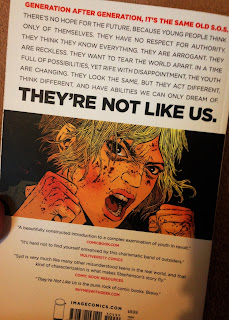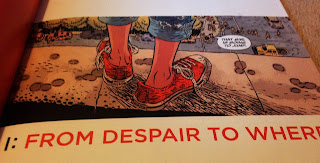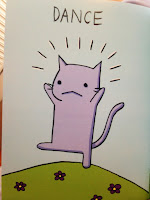I'm not going to lie - what first drew me to this book,
was the fact that the Manic Street Preachers are my favourite band of all time –
and They’re Not Like Us by Eric
Stephenson (art by Simon Gane, colour by Jordie Bellaire and letters/design by
Fonografiks) contains a multitude of nods to them.
It’s an amazing feeling to
find these in art/literature as it’s usually the Manics channelling or paying
homage to others. They are definitely a literary/artistic/political band, songwriters Nicky
and Richey (some of his favourite authors were Albert Camus, Dostoyevsky, Yukio
Mishima, Arthur Rimbaud and Philip Larkin) read widely and delighted in quoting
their favourite authors and philosophers and many of their albums reference or
are inspired by art movements and paintings.
There’s a lovely, rewarding sense of inter-textuality
across culture here, with art beginning to reflect back at the Manics
themselves.
The first, most blatant reference
is the title of this volume: Black Holes
For The Young.
This is a brilliant, psychedelic, yet fairly
obscure, song by the Manics (featuring Sophie Ellis Bextor). It’s about the
grim prospects for the future for the young when society is becoming increasingly
artificial/vacant and polluted, the tension between the urban and rural, and
the class divisions (‘no sun for you young
boy’, ‘sit around in the London smog’, ‘no more feelings that you can feel’). It channels the idea that the young, particularly the less privileged, are growing up to face black holes and vapid emptiness with no prospect or reward and this is certainly an atmosphere reflected in this graphic novel.
To introduce this series by the head of Image Comics, Eric Stephenson: They're Not Like Us sets out to tell the story of a girl with telepathic abilities, neglected by her parents, who has had enough of living. GoodReads blurb/intro: Eisner-nominated NOWHERE MEN writer ERIC STEPHENSON teams up with red-hot artist SIMON GANE for an all-new ongoing series! We all have advantages over one another, but what if you were capable of things most of us can only imagine? What would you do – and who would you be? A doctor? An athlete? A soldier? A hero? Everyone has to make a choice about how to use the abilities they're born with... but they're not like us.
The general design and layout of
the title pages resemble some Manics album cases and booklets, especially with
the epigraph/quote at the start of each issue. The first issue is another Manics song
title: ‘From Despair to Where’ (‘The place is quiet and so alone / Pretend
there's something worth waiting for. / There's nothing nice in my head / The
adult world took it all away’). Indeed, in They’re Not Like Us, Syd finds this group of outsiders who resent the adult world and the way that adults, including their parents, have treated them. The lyrics in
this song are simply brilliant, some of my favourite: ‘outside open mouthed cows / Pass each other as if they’re drugged /
Down pale corridors of routine/ … / Words are never enough / Just cheap
tarnished glitter’. It can’t be called apathy because these kids do care,
they care too much, but the care has never been returned. They were not loved, because they were not understood. They are self-declared orphans.
 A Richey Edwards (the whole culture of early Manics and the Richey era does link nicely to the story and characters in it) lyric (featured in ‘Motown Junk’) opens the
second issue: ‘Twenty-one years of living
and nothing means anything to me’, which is pretty self-explanatory. The final
words of that song are: ‘we live in urban
hell, we destroy rock and roll’. The area and house that the group in They’re Not Like Us live in epitomises that urban hell; with vandalism, violence and crime rampant.
A Richey Edwards (the whole culture of early Manics and the Richey era does link nicely to the story and characters in it) lyric (featured in ‘Motown Junk’) opens the
second issue: ‘Twenty-one years of living
and nothing means anything to me’, which is pretty self-explanatory. The final
words of that song are: ‘we live in urban
hell, we destroy rock and roll’. The area and house that the group in They’re Not Like Us live in epitomises that urban hell; with vandalism, violence and crime rampant.
The
lyrics ‘culture, boredom, alienation and despair’ (from ‘Little Baby Nothing’ - the Manics were fighting the exploitation and abuse of
women nearly 30 years ago) should be emblazoned across the top of each page of the story. They encapsulate what it is all about, both within the story and it's overall aesthetic and references to pop culture.
The volume ends with another Richey quote: ‘Find
your truth. Face your truth. Speak your truth. Be your truth’ (from ‘Judge Yr’self’, another B-side). The arc sets up Syd's quest for her own truth and her emancipation from everything she has known.
It’s very rewarding to see how some of these lesser-known songs have influenced and inspired America
creator Eric Stephenson so deeply. It’s been a joy to read some of his
interviews and see that these songs have had an impact on individuals across the Atlantic.
I
suppose there are some parallels between Syd’s character and Richey but given
what little we know about Richey’s disappearance, and whether it was suicide,
it’s probably not a valuable course to pursue.
(Minor spoilers ahead)
When we meet Syd, she is about
to commit suicide. When a mysterious stranger shows up behind her, we perhaps think he will change her mind – but instead she plummets to the ground. Her despair is
too strong. She wakes up in hospital and the stranger (introduced as The Voice)
kidnaps her, bringing her to his house of misfits – a group of young people with abilities and a
whole lot of resentment. One member is called Wire – perhaps a nod to
Nicky Wire of the Manics, and is introduced as ‘the only man I’ve met who can
honestly claim to be invulnerable’ (there you go, Nicky). At first description this sounds a bit similar to X-Men, with mutants living and being educated under the same roof by a
guardian figure like Professor Xavier and segregated by their extremes attitudes to humans. In They’re
Not Like Us, the Professor X figure is deeply disturbing, a man warped by his horrific past and
deeply un-trusting of anyone outside. There have only been six issues so far, so we are
still being introduced to the characters and story but The Voice is far from a
benevolent protector and this is much, much darker than any X-Men story.
In one interview, Stephenson spoke about an occasion where
he was mugged by a ‘group of kids who seemed more interested in just giving
someone a hard time than anything else… for a lot of young people, there’s a
growing level of dissatisfaction with the world, a feeling that there isn’t
much waiting for them as they become adults … with that in mind, I started
wondering how kids with that kind of frustrated outlook might act if they were
born with abilities that made them stand out from everyone else’. In the same interview, Stephenson acknowledges the comparisons to Professor X
and draws in Fagin from Oliver Twist, who ‘trained young orphans to be thieves’ (one of the characters is named Fagen).
 In Volume One, we only scratch the surface with many of the characters – there is
certainly a lot more to be found out, even though we do learn about The Voice’s
heartbreaking backstory – a genuinely upsetting moment and beautifully and darkly illustrated by Gane.
In Volume One, we only scratch the surface with many of the characters – there is
certainly a lot more to be found out, even though we do learn about The Voice’s
heartbreaking backstory – a genuinely upsetting moment and beautifully and darkly illustrated by Gane.
This volume collects the first 6 issues of the comic, and I
think it will be a slow build. A lot of this is just getting to know the
situation and the characters and their powers and attitudes. I personally like
this because I’m all about the psyche and the character development – but others
may find the lack of plot progression disappointing.
The art grew on me over
time – at first, I didn’t think it communicated facial expressions very well,
but there are some truly inspired pages and it actually suits the tone and captures the desensitization, now that I think
back. The opening page of the first issue is stark and effective, just
showing a pair of feet on the edge of a roof. Will she or won't she? Perhaps you expect her to
be talked down from the precipice. Perhaps all your expectations will be
confounded by this story. Syd’s first line of narration reads:
‘I live to fall asleep’.
Despair and despondency haunt these pages and ripple outwards across the panels.
Simone Gane’s full page depictions of the house that Syd ends up living in are simply stunning. They are
impressive works of art that would sit on any wall comfortably. The panels are sometimes tinged with a reddy-brown-orange, a marker of the violent energy at the heart of the group.
 |
| Syd's telepathy and being overwhelmed by the voices in her head |
As Syd settles into the house she learns about the way they
use their powers. And it doesn’t sit comfortably with her. The group goes out
and selects a person to attack, creating an illusion for the rest of the world
to see as they do it. Granted, these people are usually perverts or miscreants,
but sometimes they just happen to be walking in the wrong place at the wrong
time – endangering the cover and anonymity of the house and those in it. They attack
‘the dregs of humanity’, the ‘simple-minded tourism and vapid consumerism’
(these could be early Manics lyrics), the ‘lemmings’, ‘sheep’ and ‘zombies’.
Even Syd, the supposed moral conscience of the group, is drawn to the rush and
release of adrenaline for a time, excited by the violence and arrogance and
sheer energy of her comrades. But throughout these issues, she struggles with
where she fits in this new world. One night she reflects that everyone has ‘capacity
for good and band’ and that her ‘whole life, everyone has tried to anaesthetize the way that I feel. The whole situation was totally fucked up and wrong, and
yet … maybe… I had a right to be a little bad’. The nature of evil and where it come from seems certain to be a theme that Stephenson will explore further. But the end of the comic sets
Syd on a different path, and I can’t wait to see where it goes. I am already
impatient for the next volume – and not just for the Manics references.
This is the story of desensitized youth and what intolerance
and refusal to understand and empathise can do. And there’s so much more to
come. If it sounds like your cup of tea, and it won't be everyones, then pick it up and give it a try. Single issues are available in comic shops and digitally and the first trade volume is available in stores and through online retailers. I know I'll be looking out for Volume 2, and I'd be interested to hear what Manics fans, and the Manics themselves think of it.










